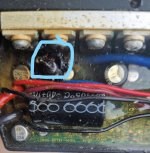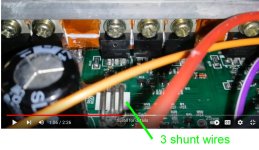Usually a high-wattage resistor like that is intended to drop the voltage from the battery positive to the positive input of the internal low-voltage power supply, which usually can't tolerate more than 20-30v. The more current that LVPS has to supply to stuff on the bike, the more current it will draw thru that resistor, and the more heat the resistor will create. So if you're running anything other than motor halls, PAS sensor, and throttle off the 5v from the controller, it might overheat the resistor.
Same thing if there is any damaged wiring on the bike, or if one of the devices powered by it is defective or damaged. (but it's likley that whatever that is wouldn't work, so if the system all works correctly until the resistor fails, this is not the problem).
The resistor also overheats if a higher battery voltage is used than the controller was designed for.
The entire controller also overheats (and the hottest things fail first) if it is enclosed inside something with no airflow and/or no heat conduction to the outside. This may be worse because of the clear potting covering the controller components, if it is not thermally conductive (probably isn't, just there to make things in the controller water-resistant).
Any combination of the above can make the problem worse.
The motor itself does not draw power from the stuff powered by the resistor, except for the motor halls (their 5V power, and the 5V pullups on each hall signal line) for a sensored motor. But if the motor is working normally, this is unlikely to be the problem. (A sensorless motor does not have any power drawn from the LVPS).
The shunts that Whatever is discussing are separate from that resistor, and in a different part of the circuit (it goes from battery negative to the FET negative busbar/traces). I have never seen a controller using a resistor like the one that is overheating as a shunt, so it is unlikely to be that in your case either.
The pic you have is not well-lit enough or in focus enough to see much; if you can take the pictures in full direct sunlight (not a camera flash) it will help. Pics from different angles would help, too, so we can see "under" the other parts that stick up and may be in the way.
Then we can tell if you have a "normal" shunt or not. (there is another "normal" shunt type that looks like a flat rectangle, usually with shiny ends and a black rectangle on it with number denoting the resistance).
karstensson said:
I am trying to help a friend figure out what is wrong with his ebike. The resistor in the picture heats up and finally burns.
He has replaced the controller and same thing happens. He also replaced the PAS and the display and that made no difference. My guessing is that there must be some problem in the Motor. But does anyone have any idea on what to test to know if the motor is causing this?
I can also add that the motor does spin for a while, but then we turn it off because the resistor gets to hot.



